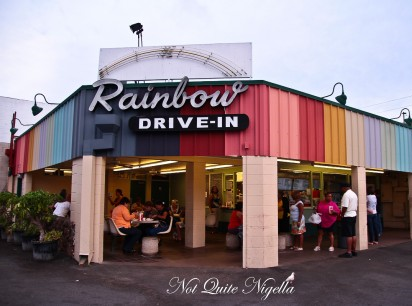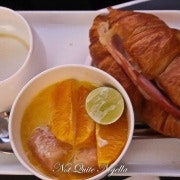Hawaiian seaside fare fit for a president
Australia's favourite food blogger Not Quite Nigella, aka Lorraine Elliott, hunts down President Obama's childhood haunts and samples authentic seaside fare in Honolulu.
Helena’s in Honolulu is truly a local’s paradise. It’s where Hawaiian teens make their last pilgrimage just before heading to the mainland to college so they can taste their last bites of kalua pig, salmon lomi, pipikaula (beef short ribs) or creamy taro puree poi.
Helena’s was started in 1946 by Helen Chock, a recipient of the James Beard award – often referred to as the ‘Oscars of food’. Helen passed away in 2007 and her daughter Elaine Katsuyoshi and grandson Craig Katsuyoshi now run the business.
I heard about Helena’s through Honolulu-based blogger Melissa Chang, who was kind enough to meet me there for lunch. The prices are unbelievably good – a set meal for two to share is $US19, but of course we want to try everything!
Traditional Hawaiian food is seafood-rich, reflecting the surrounding coastline. But it’s the short ribs pipi kaula style – or Hawaiian dried short ribs – that get everyone excited. They are marinated in a mix of chilli, soy, garlic and ginger, among other flavours. Rows of them hang drying in view behind the counter and they are served bone-in for maximum flavour.
Melissa shows us her way of eating taro poi by mixing it with the lomi salmon – which is finely diced salmon with tomato and white and green onion – to give it more flavour. She tells me that this is called ‘Brok’ da Mout’, although Cat Dish blogger Catherine Toth says it’s a cultural faux pas to do this.

Poke fish with opihi (limpets) $US5.95
Poke is a dish made with sashimi grade tuna, or ‘ahi’, cut into cubes and seasoned with garlic, onion, soy and sesame sauce. This one comes with little tendrils of brown seaweed and sliced opili, or limpets, which have a similar texture to clams. Melissa tells us that they’re an expensive ingredient, as fishermen risk death catching them. The poke only has a little seasoning on it, but you can add more soy and Hawaiian pepper water as you please.
Another favourite is the clear, crystal noodles, which are slippery and difficult to spoon onto a plate gracefully – but they’re worth every slurp. It’s comfort food, full of flavour from the small amount of broth it’s served with, and shredded chicken breast.
The jellied coconut milk rectangles have a mild sweetness to them. These can be bought by the trayful, and I see lots of people going in and out of the restaurant carrying large cardboard trays of food to take home with them.
As we leave, other customers ask us warmly where we are from and wish us well on our travels. I’d say that aloha is definitely served daily.
After Helena’s, it seems as if I am on the hunt for the president. In Honolulu, it is entirely possible to follow the president – or at least his palate. Melissa points out some buildings on her left: “Oh, that’s where Obama grew up.” Then further along, up another road, is the Baskin Robbins where he once worked scooping ice-creams.
Hawaii is a staunchly Democratic state and not just because President Barack Obama was born here. It is also very multicultural.
So where does the president like to eat? Well, he is a Hawaiian local, so he is going to find comfort in traditional Hawaiian flavours. One of his favourite places is said to be the Rainbow Drive-in, and his favourite menu item is apparently the ‘plate lunch’.

Honolulu's Rainbow Drive-in: one of President Obama’s supposed haunts
A plate lunch usually consists of two scoops of rice, macaroni salad and a meat dish of some kind. The dish originated with the sugar cane workers from Japan, China, the Philippines and Portugal, who mainly subsisted on ingredients such as SPAM and other canned goods. Fresh vegetables were hard to come by before the agricultural industry was established, so they relied on imports from the mainland.
The Rainbow Drive-in was opened in 1961 by Seiji Ifuku, who learned to cook while serving in the US Army. He aimed to serve large portions of wholesome meals to the working public and the nearby beach crowd. With its quick service, it became a popular place to eat. Today it is still frequented by tourists and locals alike.
Click here to read the full post.













